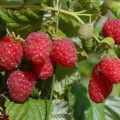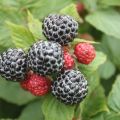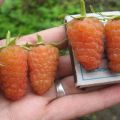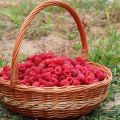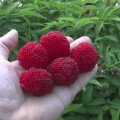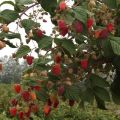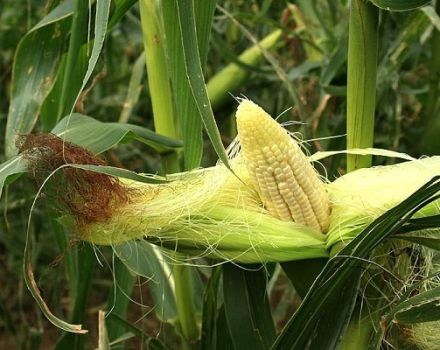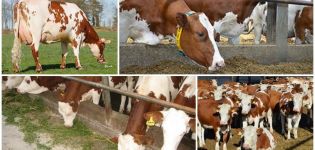Description of the raspberry variety Hercules, planting, growing and care
Raspberries are a treasure trove of beneficial vitamins and minerals, so it is no surprise that remontant varieties that yield several times per season have quickly become popular. One of these varieties is the Hercules raspberry, whose description can impress anyone. The advantage of the hybrid is not only fruiting twice a season, but also yield.
Description and characteristics of raspberry Hercules
The raspberry variety Hercules was created by a breeder from Russia I.V. Kazakov. Bushes yield up to 2 times during the growing season - in July and August. The first time the berries ripen on old shoots. The second time - for the young. The bush belongs to a slightly spreading type, in height without pruning reaches 2 m. The shoots are quite powerful, even if there is a lot of harvest on the bushes, they do not tilt downwards, therefore, a garter to the support of the bushes is not required.
Young shoots of an emerald hue, last year's become brown-purple in color and are covered with a waxy bloom. All stems are completely covered with thorns.
Among the advantages, a lot of berries are distinguished. Fruits at the stage of full maturity reach a mass of 7-12 g. The maximum weight can reach 16 g. The shape of the fruit is cone-shaped, the color of raspberries is intense pink with a red tint. The pulp is dense, sweet-sour taste with a pronounced raspberry aroma. On the tasting scale, the variety received 4 points out of 5.
Up to 2 kg of harvest is harvested from one adult Hercules bush. Due to its high and stable yield, the variety is grown not only in summer cottages, but also on an industrial scale. The variety belongs to drought-resistant and frost-resistant hybrids. But in winters with little snow, it is advisable to shelter the bushes from frost.

The main pros and cons of the variety
The main advantages of the Hercules variety for gardeners:
- taste of berries;
- yield;
- fruiting occurs twice a year;
- large berries;
- bushes are able to survive frosty winters and dry summers;
- unpretentious care.
Among the shortcomings, a weak shoot formation is distinguished; during the summer there are only three replacement shoots. Also, the bushes are completely covered with thorns, which makes picking berries difficult. Hands can be easily injured if collected without gloves.
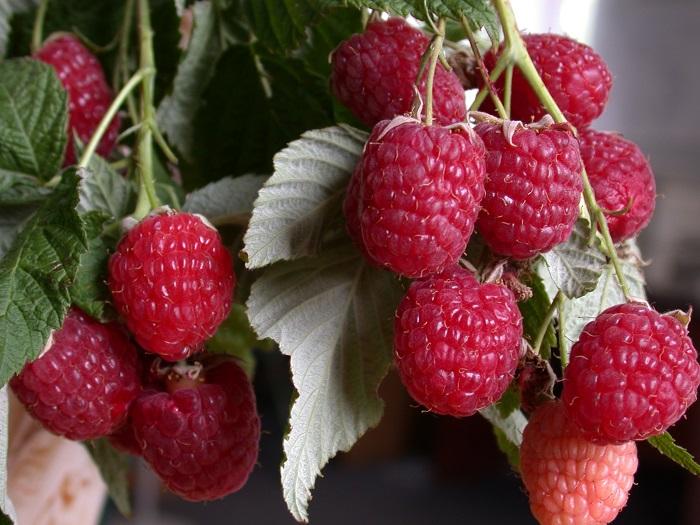
Nuances of growing berries
The cultivation of remontant varieties by technology is practically no different from the planting of ordinary raspberry hybrids. This is a crucial moment, on which not only future yield depends, but also health and immunity to diseases and pests.
What place on the site is suitable for planting?
Before you start planting raspberry seedlings, you should decide on the location. Raspberries are light-loving crops and, when planted in the shade, will bear fruit poorly. The raspberry patch should be lit from all directions for more than half of the day. Also, the site must be protected from cold winds from all directions. It is best to plant seedlings on the south or east side.
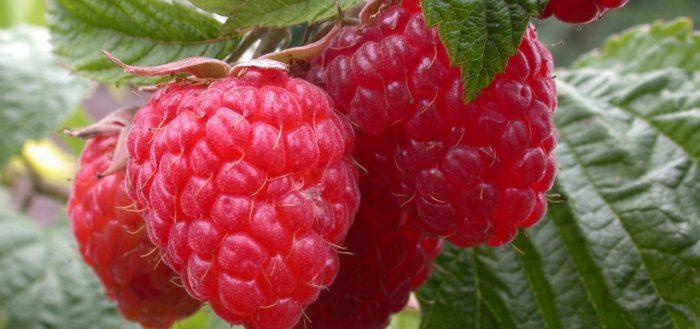
It is undesirable to place seedlings next to spreading trees. They will not only block the sun from the raspberries, but they will also absorb most of the nutrients from the soil. This will make raspberries grow worse.
The soil for planting is chosen fertile, well-drained. The most favorable is sandy loam or loamy soil.
Preparing the soil
They begin to prepare the soil for planting seedlings in the fall. During this period, the soil is dug up, all weeds are removed and rotted manure is introduced. During the winter, the soil will become fertile. In the spring, the earth is dug up again, watered with a weak solution of potassium permanganate in order to disinfect it. After that, they begin to plant.
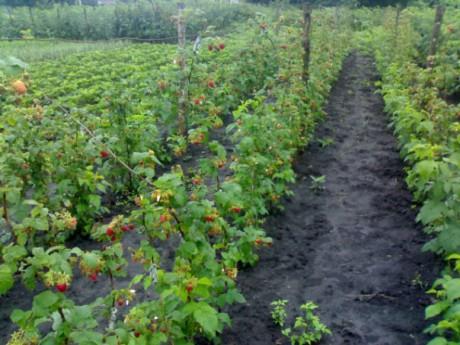
It should be dug to a depth of at least 15 cm. In the upper layer of the soil, harmful insects hibernate, and in spring they feed on the sap of young leaves of plants that grow near the wintering place.
Selection of seedlings
When planting, special attention is paid to the choice of planting material. First of all, when buying a seedling, the root system is examined. The roots should be firm, healthy and not dry. They should also be free of mold and insect marks.
The shoots should be elastic, without damage, traces of insects. Stems are red-brown in color, with a small layer of waxy coating. If there are dead branches on the seedling, it is not suitable for planting.
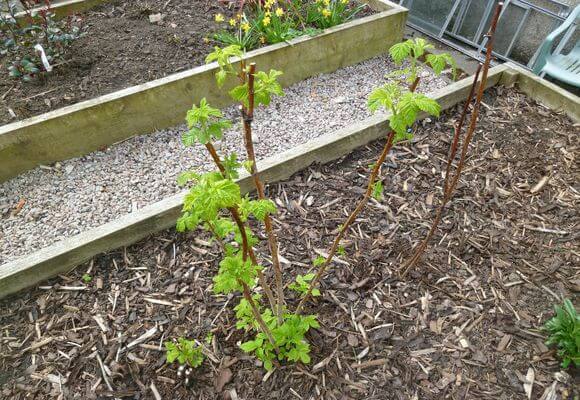
Getting started landing
Basically, the reproduction of the Hercules variety occurs by seedlings or cuttings. But the easiest way is to buy ready-made copies and plant them.
Planting process:
- Make depressions in the soil about 60 cm.
- Stick a strong wooden picket fence in the middle.
- The distance between the holes is left up to 70 cm.
- Place the seedling in the hole, bury it with soil and tamp it near the root collar.

Tie a new sapling to the picket fence. At the end of planting, pour warm water over the raspberries.
When planting raspberries Hercules
Raspberries Hercules are planted in spring or autumn. Spring is considered a favorable period for this second half of April - early May. In autumn, planting is carried out in late September - early October. The planting time of the shrub does not affect the yield.
Raspberry care rules
Like any agricultural crop, raspberries need constant care. Some gardeners neglect these procedures. This subsequently affects the yield.

Watering and feeding
Repaired raspberries Hercules' daughter cannot bear fruit without feeding. The first time the plant is fed in early May with nitrogenous fertilizers. The second time, nutrients are introduced during flowering and fruiting. Use phosphorus-potassium complex fertilizing, wood ash or diluted bird droppings. After harvesting, rotted manure is introduced into the soil.
The shrub is abundantly watered in the first half of the growing season. Then 5-6 moisturizers a month are enough.
Weeding, loosening and mulching
Several times a month it is necessary to loosen the soil in the raspberry tree. The soil is weeded to a depth of 7-9 cm. It is not recommended to loosen it deeper, so as not to damage the root system of the bushes. During weeding, all weeds are removed from the site.

So that the shrub does not die from winter frosts, the soil around the bushes is mulched. The layer of mulch should not be less than 10 cm. Peat, sawdust, straw and agrofibre are suitable as mulching material.In addition to protecting shrubs from frost, they also trap moisture in the soil and prevent weeds from growing.
Pruning
All dry and damaged branches are cut off in raspberries in the fall. It is also advisable to prune two-year-old shoots that have yielded this year. It is not recommended to touch young and healthy branches.
Wintering
In the fall, after harvesting, two-year-old shoots are cut, which have already borne fruit. Weak and dry branches are also removed. Then the raspberry tree is covered with spruce branches. If the winters in the growing region are warm, they do without shelter.
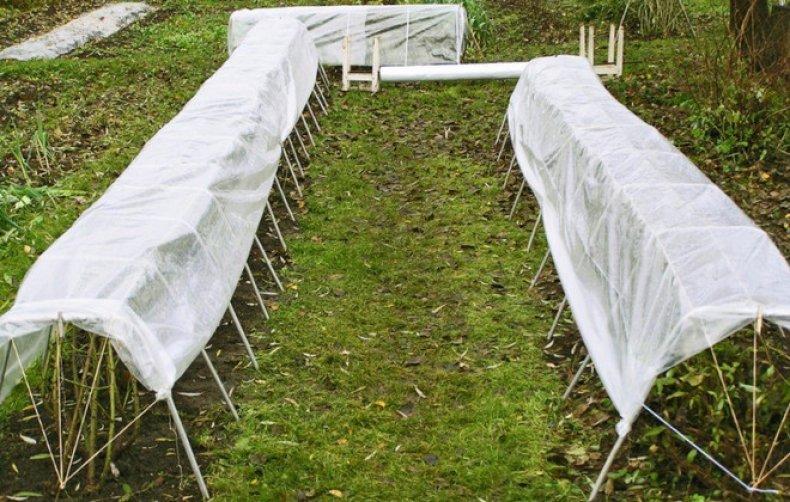
Diseases and harmful insects
Aphids are often found on raspberries. You can get rid of it by spraying with soapy water. Also on the bush there is a raspberry beetle. You can get rid of it by processing plants with karbofos. And so that insects do not appear on the plant in the spring, the soil is dug up in the fall and watered with potassium permanganate.
White and brown spots are destroyed by spraying with copper-containing preparations. Treatment of plants with Bordeaux liquid helps against rust. If a spotted mosaic appears on the bushes, it cannot be cured. We'll have to dig up and destroy the bushes. The same will have to be done if the bushes are sick with curly leaves.
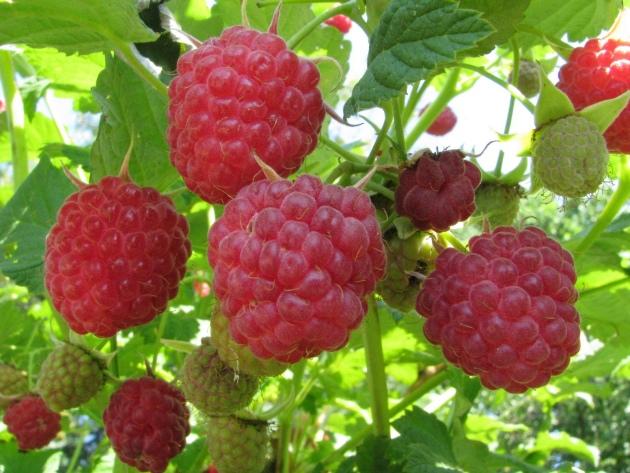
Harvesting and using the crop
The raspberry variety Hercules bears fruit twice a season. It is best to pick berries with gloves, especially if the raspberry is large. All stems of the plant are covered with thorns and it is easy to damage the skin when picking berries. It is recommended to harvest early in the morning, while the sun is just rising, or in the evening, when it has already gone down. If you pluck the fruits in the cool, then they will be stored longer. The berries picked in the heat quickly deteriorate.
It is recommended to bring large baskets or buckets to harvest raspberries. If the berries lie on top of each other in a thick layer, they quickly begin to ferment and become moldy. The berries will be stored for the longest time in the refrigerator at a temperature of +4 - +6 degrees.
The use of raspberries in cooking is extensive. Berries are used for cooking preserves, jams and compotes. Also, delicious pies and pies are made from raspberries. The berries are frozen fresh for the winter. Another way to harvest fruits is to dry them. Dried berries are used to brew tea.


